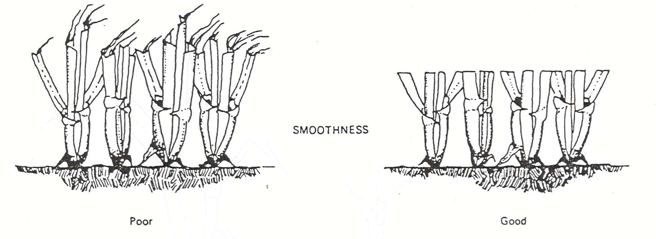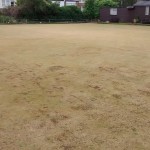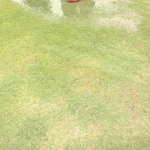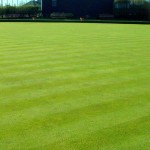Last time we took a break from the visual evaluation of the bowling green to examine the various growth habits exhibited by the grass species’ we use to create our fine turf bowling surfaces.
Today, I want to briefly return to the visual appraisal of the green and in particular I want to look at two key attributes of turf that impact greatly on green performance. One is very obvious and you probably use it to evaluate the condition of your green already without realising. The first one, however, maybe isn’t quite so obvious, but is extremely important in terms of green trueness. If you want to know why your rink has started behaving badly, this is the first place to look:
Turf Grass Smoothness

Smoothness is a component of turf grass quality that is particularly important on bowling greens. Greens must be free of obstructions or depressions that might deflect the roll of the wood. One of the key contributors to compromised smoothness is bad mowing and by that I mean mowing with poorly adjusted and/or poorly sharpened blades. This can cause a tearing action on the grass leaf which can lead to a ragged and discoloured end on the leaf. Amplified over millions of plants/shoots, this can lead to poor performance, particularly in terms of trueness. Trueness is a functional measurement of green performance that we will be looking at in more detail in a later article in this series. Bowling quality is reduced where leaf ends are not smooth. Leaf growth habit and smoothness can be evaluated by visual estimates or the trueness and distance of a bowl or jack rolling. No quick, accurate method of quantitatively measuring this component of turf grass quality has been perfected, but there are specialist tools that can be used to evaluate the quality of cut and finish on the turf. There are also a new breed of tools coming to the fore that can help us evaluate the overall smoothness of the green, but more of that later.
Colour
Here’s the obvious quality measure that you probably use unwittingly already. Colour can be a useful evaluation component as long as you understand the likely causes of differentiation in colour of turf. As radiant energy contacts the turf, certain wavelengths are absorbed and transmitted while other wavelengths are reflected. Reflective wavelengths are perceived by the human eye as the colour of the turf. Colour can be one of the best indicators to the general condition of a turf.
For example, a loss of green colour may indicate deficiency in a particular nutrient (usually Nitrogen), damage by disease or insects, or insufficient or excessive water.
Colour also differs among grass species and even among cultivars of the same species. A mid to deep green is the preferred colour for most greenkeepers, but a lack of green-ness doesn’t always indicate a problem. For example on the links land, the finest of turf can appear almost completely brown or beige in the summer, with little or no detriment to the overall playability or health of the turf.
There is a wide variation in preference among greenkeepers, but over watering and over fertilising to achieve a particular look should be discouraged. The main aim is to keep the grass healthy.
Series
This is the 6th part in a series of short articles which aims to give you the tools to make a performance evaluation of your bowling green. You can access the previous articles in the series as follows:
Part 1. The Performance Evaluation of the Bowling Green
Part 5. Turf Grass Growth Habit
That’s us finished for now on the various visual clues to performance. Next time we’ll move on to learning about the functional measurements we can make in our continued evaluation of the performance of the bowling green.






John how can I get a scythe cut?I have tried 3 different local mower service companies for sharpening and service and have disappointed with the results from all three
Hi Claud
It might be worth giving Bernhards a call to see if they can recommend a mobile service using their machinery as they will understand best what is required.
Let me know how it goes.
Thanks
John